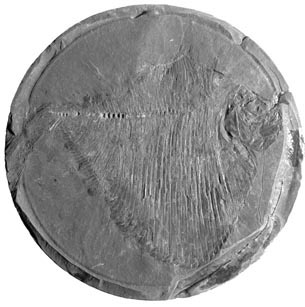Incredible Fish Fossil found in Oil Drill Core
Sometimes a scientific discovery can be down to pure chance. Despite huge advances in the technology available to palaeontologists, the finding of a brand new species can have more to do with serendipity than with appropriate planning and correct scientific practice.
The discovery of a new species of Late Cretaceous fish is a typical example of how “lady luck” can intervene and help scientists shed more light on life in the Mesozoic. In 1988, a Canadian oil company called Cequel Energy Inc. was sinking drill cores into a region of west-central Alberta, prospecting for fossil fuels.
A 75 mm wide drill was thrust more than 1,300 metres deep into the Albertan sediments. When the drill core was pulled up and examined it revealed a beautifully preserved 96 million-year old fossil fish, neatly encircled by the cylindrical drill core. Only the tip of the snout and the last part of the tail had been lost, the rest of the fish fossil neatly fitted into the diameter of core sample.
One very lucky fossil find – a Cretaceous Teleost

Picture courtesy of University of Alberta
Occasionally core samples do reveal fossils, such as the Plateosaur fossil fragments extracted by an oil company offshore Norway in May 2006, but to find a delicate fish fossil such as this is a particularly rare event.
To read about the Plateosaur remains found in the Nowegian drill core:
Norway’s First Dinosaur – Say Hello to Plateosaurus.
Fish skeletons are light and fragile, even if they avoid being scavenged and are rapidly buried, wave action and currents can quickly disperse the bones as the flesh rots away. However, in this instance the skeleton is virtually complete and perfectly preserved providing further evidence on the evolution of teleosts.
The core was taken from an area of Alberta just south of Grande Prairie, the fossil was found in core material from the Dunvegan Formation and as a result of this the fish has been named Tycheroichthys dunveganensis (means lucky fish from the Dunvegan Formation). This deep-bodied fish belonged to a now extinct group called the Paraclupeidae, which are related to modern herrings. Fish fossils from this group have been found in Lebanon and Brazil but this is the first time that this family have been reported from North America.
This fish has been referred to as a holotype (a specimen on which the original description of the species will be based). During the latter part of the Cretaceous, North America was effectively split in two by the shallow Western Interior Seaway. This sea stretched from the Gulf of Mexico to the Arctic Ocean covering the majority of Alberta during the late Cretaceous (with a few notable exceptions such as the Dinosaur Provincial Park Formation and the Oldman Formation).
The fish fossil lay amongst the other core samples for many years, under the supervision of the Canadian museum of Nature. Palaeontologists from the University of Alberta reviewed the core samples and realised the significance of the fish fossil. Their work on this amazingly lucky find has just been published in the Canadian Journal of Earth Sciences.
Articulated specimens such as this are extremely rare and given the circumstances of its discovery, it really is remarkable how this little fish fossil has survived. The fossil has now been treated to help its preservation and stored in the secure vaults in the Canadian museum.
For models and replicas of prehistoric sharks and other ancient fish: PNSO Age of Dinosaurs Figures.






Leave A Comment